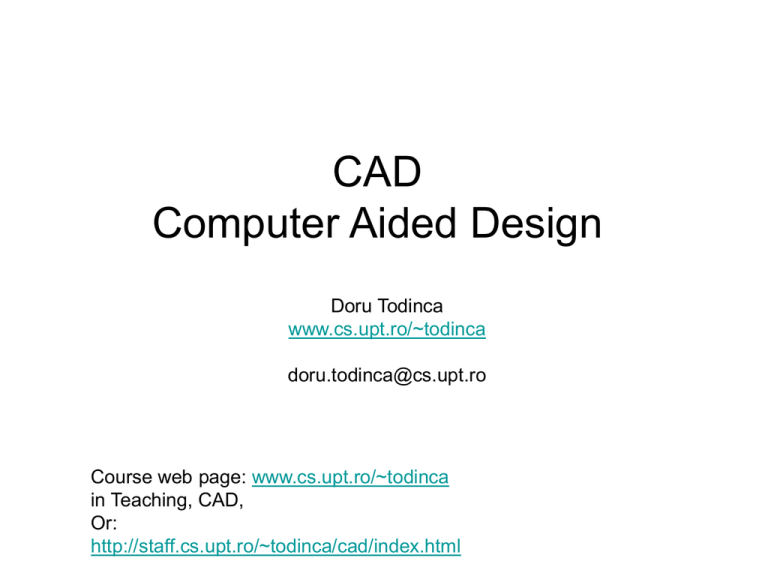
CAD
Computer Aided Design
Doru Todinca
www.cs.upt.ro/~todinca
doru.todinca@cs.upt.ro
Course web page: www.cs.upt.ro/~todinca
in Teaching, CAD,
Or:
http://staff.cs.upt.ro/~todinca/cad/index.html
Structure of the course
•
•
•
•
2 hours lectures, 2 hours lab per week
Final grade: 50% lab, 50% written exam
The lab is mandatory
Web page:
http://staff.cs.upt.ro/~todinca/cad/index.html
Assignments
•
We will focus on two projects/assignments:
–
–
•
•
VHDL modeling of a hardware system
Modeling a telecommunication system using the
OMNeT++ network simulator
One of the assignments is mandatory and will
ensure the grade for the lab
The other assignment can provide bonus
points for the written exam, and even to
replace the exam !
CAD: Motivation
•
We will learn new techniques for modelling and
simulation
We will write computer programs (more
precisely, models) that deal with:
•
–
•
Simulation time, the structure of the model,
behavior of each module, concurrency, events…
The goals of the course: to perform computer
aided design of:
1. Hardware systems
2. Telecommunication systems
First goal: designing hardware
systems
• Lectures: teaching the VHDL language:
–
–
–
–
Simulation mechanism
Behavioral modelling
Structural modelling (less than in previous years)
Circuits: registers, MUX-es, finite state machines
(FSM), etc
• Labs:
– VHDL modelling and simulation of
• a design from previous years: Booth or Robertson multiplier,
other arithmetic devices, or a μP or μC
• Or of a new design: fuzzy logic controller (FLC),…
– For more details see the webpage
Second goal: telecom systems
• Lectures:
– Quality of Service (QoS) and QoS differentiation in
Internet
• Architectures for QoS in Internet: Integrated services
(IntServ), Differentiated services (DiffServ)
• Techniques: scheduling, admission control, routing,
congestion control, queue management, etc.
– Mobile communications:
• basics, LTE (4G), 5G
• Labs:
– Learning the OMNeT++ network simulator: open
source network simulator based in C++
– OMNeT++ model of a part of a DiffServ architecture,
or of a part of a mobile system
– Collection and interpretation of the simulation results
Why VHDL ?
• VHDL is a representative hardware
description language (HDL)
• It is a standard language (IEEE 1076-1987)
• It contains features specific to HDLs:
– Simulation mechanism, simulation time,
processes, structural descriptions,
configurations, etc.
• It has capabilities specific to high-level
programming languages:
– IF, CASE, LOOP statements, subprograms, etc.
Why OMNeT++ ?
• There are many network simulators:
– Commercial: OPNET, SES/Workbench
– Non-commercial: ns2, ns3, …
• OMNeT++ is a free (non-commercial)
open-source network simulator
• It is easy to learn and to use:
– It is based on C/C++ for behavioral modeling
– Uses predefined functions that model
modules’ behavior (handleMessage, activity,
finish, initialize)
Why OMNeT++ ? (cont’d)
• Can be easily used for high-level
modelling
• Has also frameworks for more detailed
modelling of IP systems, mobile ad-hoc
networks, etc
• Good graphical interface
• Capabilities for displaying and processing
simulation results, etc.
• Examples, tutorial, user manual…
References
• [EKP98] Petru Eles, Krzysztof Kuchcinski, Zebo Peng,
“System Synthesis with VHDL”, Kluwer Academic
Publishers, 1998 (chapter 2, mostly for behavioural
modelling)
• [Bha95] J. Bhasker, “A VHDL Primer”, Prentice Hall,
1995
• [Ash] P. Ashenden, “VHDL Cookbook”, www… -mostly
for assignments
• [Omn10] OMNeT++ User Manual, Version 4.1. Andras
Varga and OpenSim Ltd, 2010. [Online]. Available:
http://www.omnetpp.org/
• [Sta07] William Stallings, Data and Computer
Communications, Eight Edition, Pearson Prentice Hall,
2007 (for DiffServ)
• Power Point slides
Sources
• The VHDL part of the lectures is based on
[EKP98] (for behavioral modelling and dataflow
modeling, except BLOCKs, and [Bha95] for
BLOCKS, structural modelling, advanced topics)
in the sense that the CAD lectures contain ideas,
figures and text from [EKP98] and [Bha95]
respectively. When other sources are used, it will
be mentioned.
• The Omnet part is based mainly on [Omn10],
meaning that it contains ideas, text and images
from [Omn10], when not stated otherwise.








